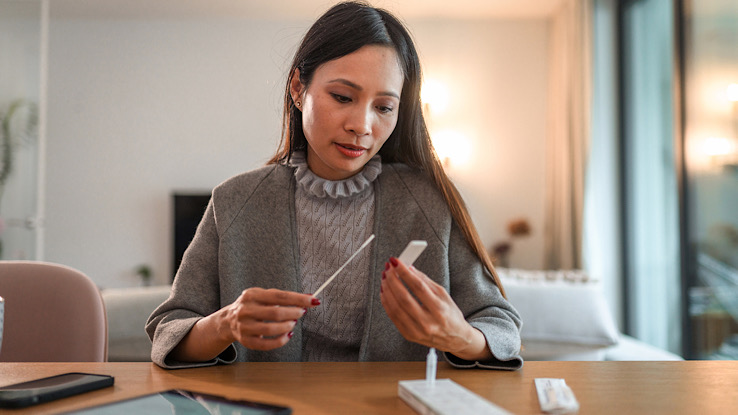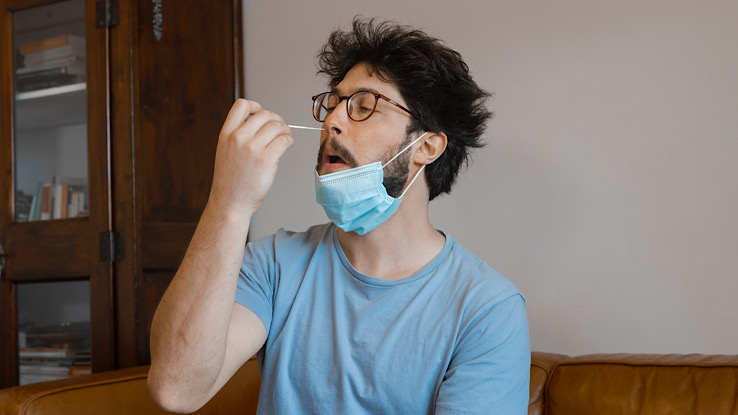
Coronavirus Disease 2019 (COVID-19) is a respiratory virus that has affected all of us. Between March 2020 and March 2022, there were 80 million COVID-19 cases and 1 million COVID-19 deaths in the US alone. As we learn more about the virus, the ways to protect ourselves and others from the virus have improved. These include getting vaccinated, wearing a well-fitted mask, physical distancing, and testing for the virus— including at-home COVID tests.
This article will help you understand different types of COVID-19 at-home tests, where to get at-home testing kits, how to perform a COVID-19 self-test, and what to do after getting your at-home test result.
What Is COVID-19?
COVID-19 is a virus that causes respiratory illness that can lead to other long-term health conditions and even death. The first case of the virus was in December 2019 and has spread rapidly, causing a global pandemic. The virus can spread from person to person via virus particles or droplets through actions such as breathing, coughing, sneezing, laughing, and singing. It can accumulate in enclosed spaces where there are a lot of people and poor ventilation. People wear masks, avoid close contact with others, and keep rooms ventilated for these reasons.
If you are exposed to the virus and become infected, you may have symptoms within 2 to 14 days. Symptoms include:
- A new continuous cough
- Fever (high temperature)
- Difficulty breathing or shortness of breath
- Muscle aches
- Sore throat
- Loss of taste and smell
- Headache
- Fatigue
- Diarrhea
- Nausea and vomiting
- Congestion or runny nose
It is important to remember that you may have no symptoms even though you are infected.
What Are COVID At Home Tests?
Self-testing for COVID-19 at home can help prevent the spread of the virus. At-home COVID-19 tests are quick and easy tests to do. They are available without a prescription, and the sample does not need to be sent to a laboratory for testing. They detect current COVID-19 infection and give results in a few minutes.
At-home tests DO NOT detect antibodies, meaning they cannot tell you if you have previously been infected with COVID-19. They also DO NOT measure your level of immunity to the COVID-19 virus.
Why You May Want to Take a COVID At Home Test
IIf you have COVID-19, you are contagious to other people up to two days before your symptoms appear. You may be contagious to others for another 10 to 20 days. Even if you have no symptoms yourself, you can still be contagious to others.
COVID-19 at-home tests, also called home tests, self-tests, or over-the-counter (OTC) tests, are an important line of defense in protecting people from the COVID-19 virus. You should take an at-home test:
- If you begin to have COVID-19 symptoms
- At least five days after you have been in contact with someone with COVID-19
- Before you gather with others — especially people at risk of severe disease, older people, immunocompromised people, or people (including children) who do not have up-to-date COVID-19 vaccinations.
An at-home test will help you know if you have the COVID-19 virus and help you avoid spreading the virus to others.
Types of At Home COVID Tests Available
The Food and Drug Administration (FDA) has approved two types of at-home COVID-19 tests – antigen and molecular tests. A list of FDA-approved brands is available here.
Antigen tests
Antigen tests are the most common type of at-home COVID-19 test, and people with or without symptoms can take them. The result of your antigen test is available within 10 to 30 minutes (depending on the brand).
Molecular tests
People with or without symptoms can take molecular tests, and the result is available within 20 to 60 minutes. Molecular tests generally require a reader sold separately from the test kit.
Where To Get an At Home COVID Test
At-home COVID-19 tests are now available for purchase or may be provided to you by the government free of charge up to a certain limit per household. Get your at-home testing kit either by:
- Ordering for free online or by telephone. Every home in the US is eligible to order 2 sets of 4 free at-home tests. These are rapid antigen tests and can be ordered online or by telephone. The online link and telephone number are available here. These tests are available to everyone and do not require ID, credit card, or health insurance. US Postal Service (USPS) delivers these tests to you and usually ships within 7-12 days of ordering.
- Purchasing from your local pharmacy. At-home COVID-19 tests are available for sale throughout the US. Your local retailer or pharmacy can tell you where at-home tests are available near you. If you have employer or Marketplace health insurance, your insurance will pay you back for 8 at-home tests per month for each person in your plan. Learn more about test kit insurance cover here.
Steps To Perform an At Home COVID Test

Doing your at-home COVID-19 test is quick and easy. Each test kit contains:
- A test swab
- A dropper and liquid
- A test card
- An instruction leaflet
Read the test instructions included in the test kit, as procedures may vary slightly from one brand to the next. The following general guidelines are also available in a video here.
- Use a disinfectant spray to clean the surface where you will conduct the test
- Wash your hands thoroughly with warm water and soap
- Insert the swab one-half to three-quarters of an inch inside each nostril, rotating the swab five times per nostril. This does not hurt but feels a little strange
- Open the dropper and place the swab into the liquid. Twirl the swab 15 times in the liquid
- Throw away the swab
- Replace the lid on the dropper
- Place three drops of the liquid onto the collection chamber of the test card
- Following the length of time indicated in the instruction leaflet (between 10 and 20 minutes), you can read your results
- The test card contains the letters C and T. If the test is valid, a solid line will appear at C. If this line does not appear, the test is invalid. You will have to repeat the test using a new test kit.
- A line at T signifies that you have tested positive for COVID-19
What Happens After You Take a At Home COVID Test?
What you do next depends on your result.
- A positive test result: If you have tested positive for COVID-19, you should isolate yourself from friends and family and follow up-to-date COVID-19 guidelines. Wash your hands well and frequently. If your symptoms worsen – such as shortness of breath or difficulty breathing – go to your local emergency department.
- A negative test result: If you have symptoms or have been in contact with someone who has tested positive for COVID-19, consider testing again 1-2 days after the first test.
How Accurate Are At Home COVID Tests?
At-home tests are not as accurate as laboratory-based polymerase chain reaction (PCR) tests, which can detect smaller quantities of the virus. They also should not be used in isolation but as part of a group of actions and practices like vaccination, mask-wearing, and physical distancing. This will help you protect yourself and others from the virus.
Resource Links
- “COVID-19” via Centers for Disease Control and Prevention
- “Self-Testing” via Centers for Disease Control and Prevention
- “ What is Coronavirus” via Johns Hopkins Medicine
- “Get free at-home COVID-19 tests” via COVID.gov
- “How to do an at-home COVID-19 rapid antigen test correctly” via UC Davis Health
- “If You Are Sick” via Centers for Disease Control and Prevention
- “Testing for COVID-19 at home” via Mayo Clinic





